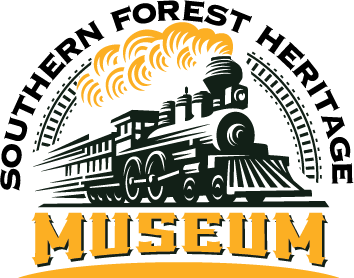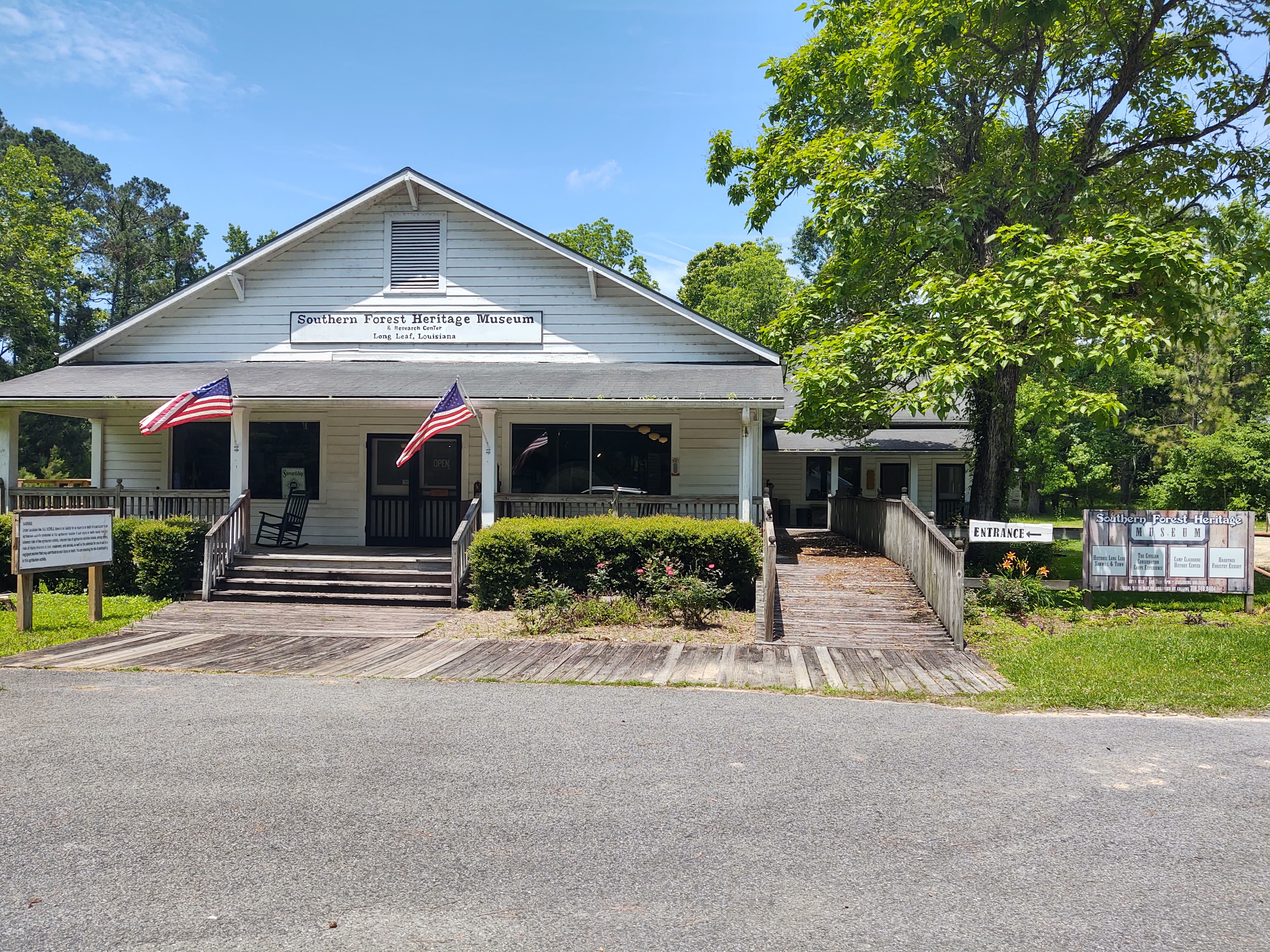The Museum complex is large, about 60 acres worth to explore, and visitors seldom have time to view all the exhibits. A driving tour has been developed to provide enough information about each stop to help you select those in which you have the most interest in to stop and investigate. The tour begins at the entrance of the museum complex, the Commissary, where you pay your admissions and are given the brochure with the driving tour information. Admission is $8 for adults, $5 for children 6-12, children 5 and under are Free.
You can download a PDF of the guide (print or save) if you wish to have a plan to tour, or to see what we offer at the Southern Forest Heritage Museum & Reserch Center, before visiting.
- Stop 1. Naval Stores and old Post Office
- Stop 2. Caroline Dormon, Camp Claiborne Exhibit (WWII) , and Henry Hardtner Office,
- Stop 3. The Civilian Conservation Corp Exhibit, The Dawning of Sustainable Forestry Exhibit, Recovering From a Natural Disaster Exhibit, and The Role of Fire in Ecosystem Management Exhibit (CCC cabin),
- Stop 4. The Planer Mill
- Stop 5. The Planer Mill Power Plant
- Stop 6. Rehaul Skidder, Locomotive #400, and Engine House
- Stop 7. McGiffert Log Loader, Machine Shop, and Locomotive #106
- Stop 8. The Sawmill
Stop 1. Naval Stores (Turpentining) Exhibit and Old Post Office
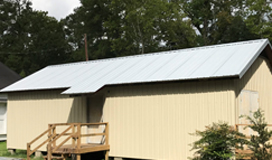
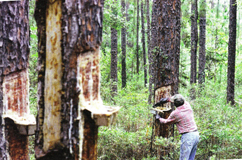
Naval Stores:
Beginning in the 1600s and continuing for over 400 years, naval stores or turpentining operations became a driving force for the young nation’s economy. Chipping or hacking longleaf pines was used to produce resin, called gum. From gum, products like tar, pitch, turpentine, and rosin were used to maintain the sea worthiness of sailing vessels. In Louisiana, these products were obtained largely from chipping and later from distilling the pine stumps remaining after harvest of the virgin pines.
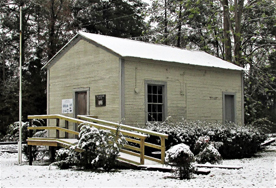
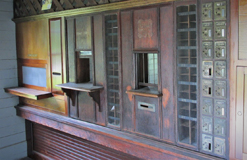
Post Office: The Post Office building from 1912, that served as the second post office for the town of Long Leaf for over 50 years. A visit to its interior provides a look at the functioning of such an early facility.
Stop 2. Caroline Dormon, Camp Claiborne History Center (WWII), and Henry Hardtner Exhibits
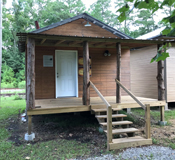
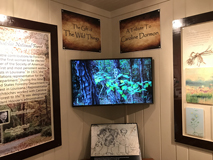
The first building at Stop 2 is the Caroline Dormon Exhibit, that tells of the remarkable contributions she made to the development of forestry education during the early 20th century. Dormon was the first woman elected into the Society of American Foresters. Later, her efforts in hybridization of irises and her writing of important books on native plants led her to be recognized as one of the eight leading naturalists in the nation
The second building at Stop 2 houses two different exhibits in one building: Camp Claiborne Exhibit (WWII),and Henry Hardtner Exhibit.
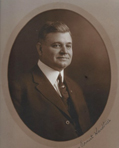
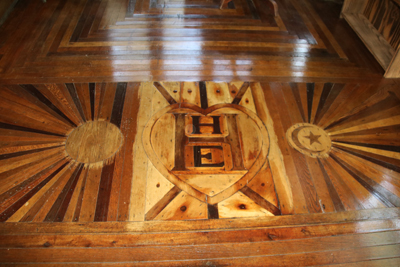
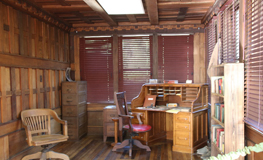
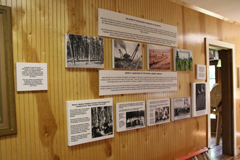
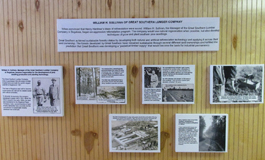
The building itself was Henry Hardtner’s office and carriage house in Alexandria, LA. Hardtner, President of the Urania Lumber Company at Urania, became the advocate for the possible reforestation of the pine forests decimated by the massive lumbering of the early 20th century. It was his leadership, along with others, that led to the development of reforestation technology that restored the South’s forests. Because of his efforts, he became recognized as the “father of southern forestry.”
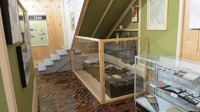
On the other side of the building is the Camp Claiborne Exhibit. Nearby on Highway 165 is Camp Claiborne that was established in 1940 and closed in 1947. It was a major U.S. Army training center. Housing 50,000 troops, it was one of the largest camps in the nation. It was here that the 82nd and 101st Airborne Divisions were created. The exhibit details the remarkable history of the units as well as the Claiborne-Polk Military Railroad and the Corps of Engineers-Engineer Unit Training Center.
Stop 3. Civilian Conservation Corps Exhibit, The Dawning of Sustainable Forestry Exhibit, and the Fire in the Forest Exhibit
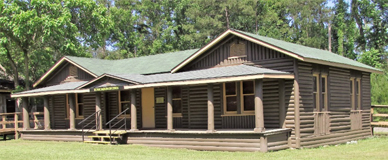
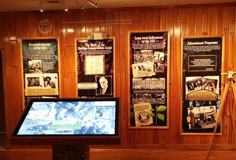
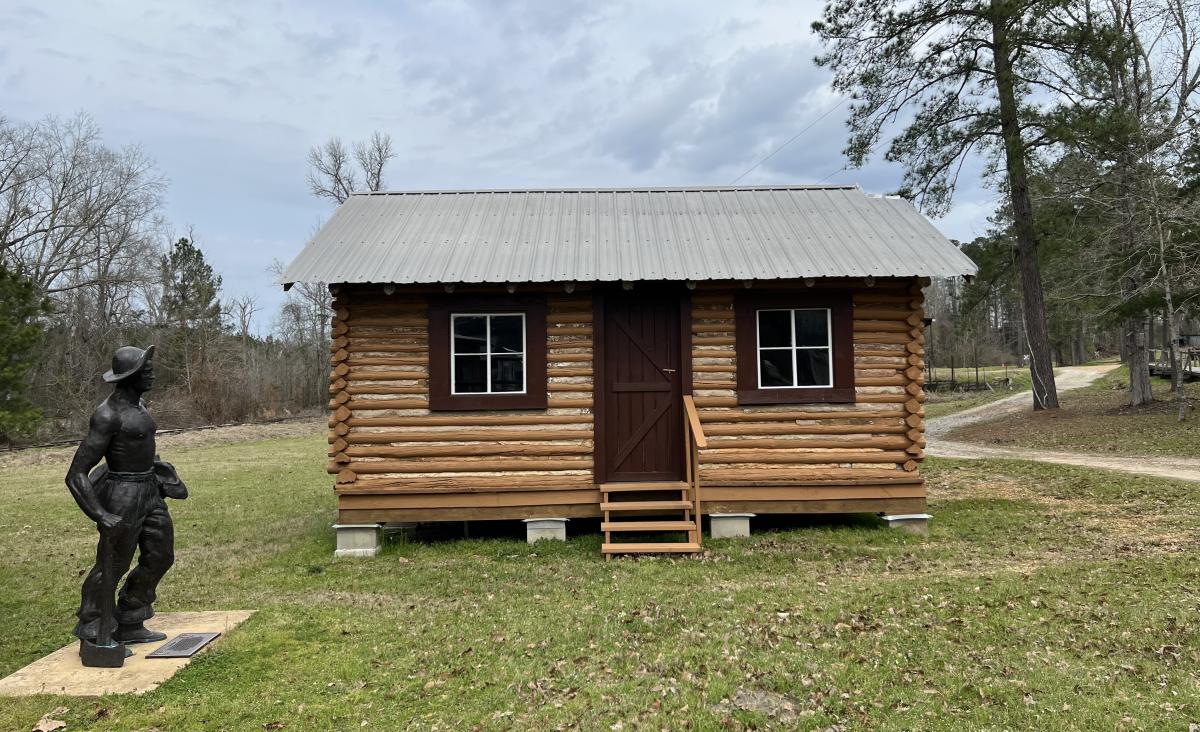
Created by President F. D. Roosevelt, the Civilian Conservation Corps (CCC) was to "save our land, save our forests, and save our young men" during the Great Depression. It was a public work relief program that operated from 1933 to 1942 in the United States for unemployed, unmarried young men from relief families, ages 18-25. They did various work in the conservation efforts of southern forestry. The Civilian Conservation Corps Exhibit Building was a lodge constructed by the CCC.
In the early 20th century, just a few lumbermen, researchers, and interested individuals accepted the challenge of beginning reforestation efforts. This is a markable history, and their influence on the development of forestry in the South became the guiding force that helped in the economic development of the South. A document published by the Forest Service Southern Research Station captures this remarkable history. The Fire in the Forest Exhibit explores this history from its beginnings to present day. You will also discover the Recovering From a Natural Disaster Exhibit as well.
The log cabin was built by Civilian Conservation Corps crew in 1935 and was used as temporary living quarters for "standy-by" fire suppression crews. .

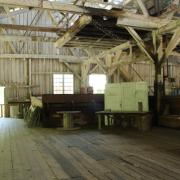
The purpose of the Planer Mill was to produce finished lumber and millwork out of rough dry lumber. The mill, built in 1910, is one of the oldest buildings on the site. The building is large and built of very heavy timbers providing strength in case of fire. By using large timbers, the building would not collapse unless the fire burned for a long time. Specialized products including delicate moldings, beaded sheathing, and tongue-and-grove flooring were milled here.
Stop 5. The Planer Mill Power Plant
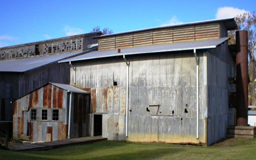

Adjacent to the Planer Mill is its Power Plant. The facility hosted three boilers that burned wood waste from the Planer Mill to generate steam that powered the giant engine. Steam from the boilers was piped to a large Corliss steam engine that powered a 120-foot shaft that extended under the planer mill. All equipment was powered by belts extending up from that shaft. The engine powered a 12-foot diameter flywheel with a 4-foot race.
Stop 6. Rehaul Skidder, Locomotive #400, and Engine House
Stop 6 has three different locations marked on the map, past the railroad tracks. Please DO NOT DRIVE OVER TRACKS, you must walk to each spot.
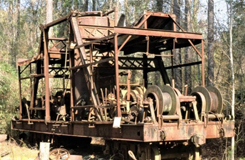
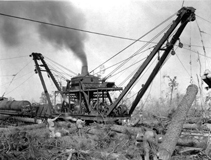
Going to the left in the woods along the railroad tracks is the rare Clyde Rehaul Skidder—a massive piece of equipment. This piece of equipment pulled harvested logs to the rail track for loading on log cars. From attached booms, four cables pulled logs from nearly 1,000 feet and then the cables returned to the area of cut logs—hence the name rehaul. It could at one setting on the track pull logs from a 40-acre area. The logs would be loaded on rail cars by a steam-powered loader. This is the only steam-powered skidder known to now exist. It was so powerful that little standing vegetation remained after its operation.
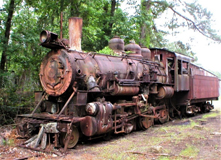
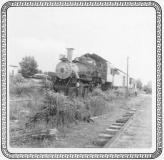
Next to the Clyde Skidder is Locomotive #400 which was built by Baldwin Locomotives and was used to pull log trains for the Crowell & Spencer Lumber Company. It made its last run in 1954 and has been parked here since then—not protected from the weather. Such locomotives could pull up to 20 loaded log cars. It was converted from burning wood to oil and both water and oil for its operation were carried in its tender (behind the engine).

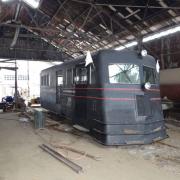
Going back along the tracks to the first building seen is the Engine House, commonly called the Roundhouse, is where locomotives were maintained and repaired. There is an inspection pit for access underneath engines. Men filled the tenders with fuel oil and water here and kept the engines warm overnight. Equipment now in the Engine House consists of rail motor cars (M-1, M-2 and M-8) and the M-4 rail passenger car. Typically, these rail passenger cars were called “doodlebugs.”
Stop 7. McGiffert Log Loader, Machine Shop, and Car Knocker
Stop 7 has two different locations marked on the map, past the railroad tracks. Please DO NOT DRIVE OVER TRACKS, you must walk to each spot.
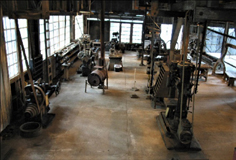
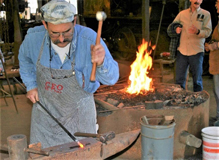
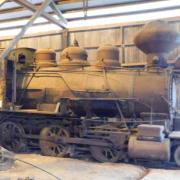
The Machine Shop is where the sawmill depended on all repairs and modifications of machinery to take place. In it was the forge, wheel press, lathes, and other equipment needed to maintain the mill and its equipment. The machine shop was powered by an overhead belt and line-shaft drive system. In the 1950s, the steam-powered engine was replaced with an electric motor. This type of drive system has survived in only a few industries. In the Machine Shop is Locomotive #202, built by Baldwin Locomotives for the Meridian Lumber Company (created by the Crowells) and eventually belong to Crowell Long Leaf Lumber Company in 1950. #202 was parked outside for many decades and has rusted badly. There are plans to restore it soon. The #202 has a distinctive cabbage-head stack, an indication that it was a wood burner that was used to pull log trains.
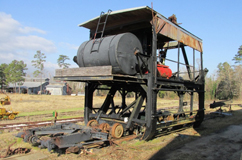
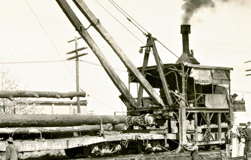
On the track in front of the Machine Shop is one of two McGiffert loaders owned by the Museum. This one has been under restoration by two volunteers for several years. The loader moved along the track to where the Clyde Skidder had gathered logs. Once at a setting, the loader lifted its wheels up under the cab/deck floor. When the wheels were raised, the shoe at the bottom of the legs would rest on the ends of the ties outside the rails. With the wheels raised, the loader could pull empty log cars though the opening to be loaded.
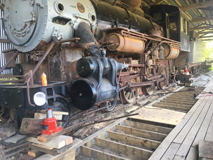
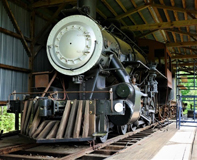
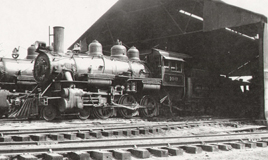
The Car Knocker Shop was a building designed as a repair facility for log cars. Because of the noise that came from the shop from repairs, it was called “car knocker.” Inside the Car Knocker Shop is the Locomotive #106. #106 was built by Baldwin Locomotives for the Red River & Gulf railroad (created by the Crowells). The engine was parked under cover and is the best maintained of the three locomotives owned by the Museum. An extension effort led by volunteers is underway to restore the engine to its original appearance. Parked behind the engine is a 43 ft. log car, the Crowell lumber companies had 2 sizes of log cars, one 43 ft and other 31 ft long. Of hundreds in use at the sawmill, this one is the only one remaining. Others rotted away or were burned.
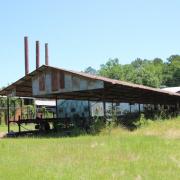
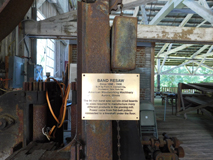

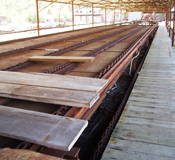
The Sawmill is the oldest complete sawmill in the South, and perhaps in the entire country. The building was constructed in 1910, remodeled in 1917 and 1936, and renovated in the mid-1950s. In it is all the standard operating equipment needed to convert logs into lumber. It is here where workers were trained to operate the latest in mill industrial equipment. Lumber came out to the Green Chain where it was sorted by grade and size and then moved to either to the Dry Kilns or stored in Lumber Yard/Lumber Storage. From there, it was moved to the Planer Mill for conversion into marketable lumber.
Next to the Sawmill is the Fuel House and Turbine buildings, these buildings are no longer part of the tour as they are not easily accessible or safe to be inside. Originally the Fuel House was the Boiler House, the two have now been combined, and this is where the steam power to fuel the Sawmill and Dry Kilns came from. The Turbine was added in 1957 with the electrified Sawmill, it produced 1.5 megawatts and could only power the light bulbs and a few pumps and cylinders. The rest of the Sawmill and Dry Kilns used the Fuel House for steam power.
The tour ends back at the Commissary.
Take Away: It was lumbering that brought workers into sawmill towns such as Long Leaf. Their families were provided education in schools, medical care, access to churches for worship, and a Commissary where food stuff and supplies were available. Lumbering in thousands of towns like Long Leaf was responsible for the economic recovery of the South following the Civil War. Workers, both black and white, come into sawmill towns where they received training that moved them into the industrial age. Life in these towns helped shape the society and culture of the South.
Outside Of the Museum:

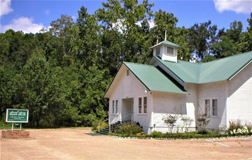
Leaving the Museum on LA 497 visitors can observe the last three surviving churches from the Long Leaf Mill. Churches in sawmill towns not only met the spiritual needs of the town inhabitants, they also functioned to bring the community together by hosting events supporting the children and youth and by welcoming and engaging newcomers who came into the town.
Going left to Forest Hill, visitors can drive by the last two of four colored churches—Mount Zion Missionary Baptist Church and Magnolia Church—that were built for the black Long Leaf employees, which made over 60% of the workers at the Long Leaf Mill. If turning right to Glenmora, visitors will pass the only white church—Long Leaf Baptist Church—that was built for the white employees of Long Leaf Mill.
